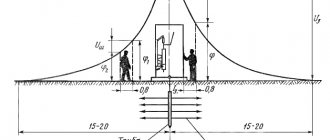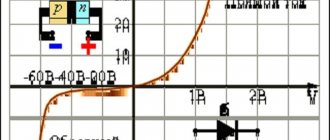Step voltage is the potential difference in the area of the earth where current flows, with a distance between points equal to a standard human step, that is, 0.8–1 m . The value of this indicator depends on the physical properties of the soil (resistivity), frequency and strength of the current spreading over the area, and a number of other parameters.
Those under its influence feel tingling in the legs, and in severe cases, cramps appear. In panicked attempts to leave the emergency zone, an unprepared person tries to run away, and quickly with the maximum possible stride length. In many cases this causes death.
Due to the effect of electric current dissipation, the risk of injury from step voltage decreases with distance from the point of contact of the emergency wire with the ground. At a distance of 20 m under normal conditions, the probability of receiving an electric shock tends to zero.
Reasons for its appearance
In the immediate vicinity of high-voltage power lines, in areas with cable communications, there is a danger of the occurrence of such a phenomenon as step voltage. A similar effect occurs under various circumstances. For example, the cause of the appearance may be a power line break, in which one of the conductors fell to the ground. In addition, the zones located around the standard grounding conductors of electrical equipment also pose a danger in emergency situations with a short circuit to ground.
There is a possibility of step voltage occurring when the insulation of high-voltage underground cables breaks down when automatic protective devices that are supposed to de-energize the line in emergency situations fail.
For this reason, it is not recommended to stay in areas where power lines and underground utilities are located, especially in conditions of high humidity, and even more so during rain.
Historical reference
In the history of electrical engineering, there is an educational incident that happened in what was then Leningrad in 1928, known as the “horse accident.”
On one of the areas lined with wooden hexagons there was a technical well made of cast iron with a 2 kilovolt switching circuit breaker. At a certain point, the insulator cracked and the disconnector remained hanging next to the wall on the cable. After the rain, the wooden pavement became wet, soft and mobile. Then a horse with a loaded cart passed from above, the surface bent, and the cable shorted to the cast iron.
Citizens in the step-voltage zone were treated with simple electric shocks, but the horse, which had a body one and a half meters long with highly conductive iron horseshoes on its legs, died on the spot. Then the circuit breaker turned on at the electrical substation and de-energized the circuit.
The cart was removed, eliminating the short circuit. After checks at the substation, the current was applied again, and an electric arc appeared between the well and the disconnector. Stepping tension arose on the pavement, killing two more horses of police officers.
Types of step voltage
The most dangerous is the step voltage that occurs with a single ground electrode. This case can be compared to the situation with a power line falling to the ground. In this case, the maximum potential will be precisely at the point of contact with the surface or at the installation site of the ground electrode.
Also read: How and with which fire extinguishers to extinguish wiring
Due to the dissipation of current along the ground, with increasing distance from the grounding point, the potential value decreases, and the value changes along a curved curve, with a maximum decrease precisely in its first section. Therefore, the most dangerous step is considered to be one in which one foot is located directly on the wire or above the ground electrode, and the second at a distance of 0.8–1 m. Being at a distance of up to 8 m at a voltage of no more than 1 kV is considered potentially dangerous, and for high-voltage networks this the indicator decreases to 4-5 m.
A similar picture is observed in the presence of group grounding conductors, with the only difference being that the total potential is distributed over all grounding conductors. That is, the total step voltage (potential difference) at a distance of one human step will be less. And when your feet are on different grounding conductors, no consequences will be felt, since they have the same potential value.
Definition
What is step voltage? This is a certain voltage that occurs between the legs of a person standing next to a grounded object without touching it. It is equal to the difference in electrical voltage between an object and a point that is located at some distance from it. The main factors influencing it are distance, earth resistivity (ground grid) and current flowing through the conductor.
Photo - Example of a step voltage vortex
The danger of step voltage is that touching is not necessary for electric shock, and after shock, movement is almost impossible. Due to the fact that the earth also has a certain specific voltage, an impact can occur regardless of human actions.
Photo - Dependences of step sizes and voltage
Step Voltage Values
From the physical prerequisites for the occurrence of such an effect, it becomes clear that the magnitude of the step voltage depends on the distance from the ground electrode or fallen wire, and the distance between the feet.
In this case, the following main values can be distinguished:
- Maximum - occurs in cases where one foot is on the wire or on the ground above the grounding electrode, and the second at a distance of 80–100 cm. This is explained by the steepness of the drop in the curve of the potential versus the distance to the grounding point. It is in this area that the potential difference will be maximum.
- The minimum value is possible only at a significant distance from the point of contact of the wire with the ground. In this zone, the dissipation of electric current is no longer observed, so a potential difference does not arise at any step size.
- A zero value is typical for those situations when the feet are on points characterized by identical potentials. This becomes possible if you stand on the elements of a group grounding electrode or keep your feet almost close.
It is on these data that the rules for exiting the step voltage zone that occurs in an emergency are justified. Practice has shown that these recommendations should be followed until the distance to the center of the zone exceeds 20 m.
Also read: Purpose of silica gel in transformers
Physics and physiology
Step voltage is the potential difference between two sections of soil. When lightning strikes, current “spreads” into the soil, creating an area of high potential. If there are conductors nearby, a circuit can form. A person can become such a conductor: the current enters through one leg and exits through the other, turning the body into a “load”. This situation is extremely dangerous, since high voltage causes muscle paralysis, like from a stun gun. As a result, a person may fall on his hands, and, with multi-component lightning, the current of subsequent discharges will go through the heart, increasing the risk of cardiac arrest. If your head touches the ground, the risk of irreversible damage to the central nervous system increases dramatically.
It will be interesting➡ Joule Lenz's Law - the most complete theory
The right side of the figure schematically shows the effect of step voltage, which creates a load through the legs (red arrow) - that's why it got the name step voltage. Conventional lightning can carry tens of thousands of amperes of current (I1-2), resulting in a potential difference (V1-V2) that can exceed tens of thousands of volts. Since there is a voltage difference between two points (legs), the human body represents a complex electrical resistance and acts as a load. The amount of current (Ib) passing through the body in this case depends on the resistance of the foot (Rf) and body (Rb).
Step Voltage Hazard
The problem is that the impact of lightning pulse current on living organisms has been poorly studied. It is possible to calculate the approximate value of current and step voltage, but the result of their interaction with the human body is less predictable. Lightning strikes, including those with step voltage, have unique “physiological features.” First of all, this is due to the fact that although lightning carries a huge amount of energy, it is released in a very short period of time: 1/10000-1/1000 of a second. Such shocks rarely cause severe burns or damage to internal organs, as is the case with electric shocks from conventional electrical equipment. But lightning can affect the heart and nervous system, including peripheral nerves.
Therefore, the consequences of a step voltage shock can be unexpectedly significant and very diverse: from cataracts, paralysis of the limbs and chronic pain to sleep and mental disturbances, hearing loss, memory loss, etc. The most common cause of death is cardiac arrest.
In his webinars for designers of lightning protection systems, Doctor of Technical Sciences, Professor Eduard Meerovich Bazelyan has repeatedly noted the lack of a clear definition of the dangerous value of step voltage. Thus, it is known that the pulsed impact of 6 kV lightning can cause cardiac fibrillation and possible cardiac arrest. But the physiology of the human body is complex, and even less exposure can cause severe injury and lead to death. In the case of pacemakers and other channels of direct current access to the heart muscle, a short-term exposure of 1 mA is sometimes sufficient to cause fibrillation.
At the same time, the high resistance of dry skin is not reliable protection. With step voltage it is even more difficult, since the current usually flows through the limbs, and joints have higher resistance than blood vessels and muscles. Because of this, tissues near the joints can become very damaged, leading to disability. A striking illustration of the formidable power of step voltage was the case of mass death of deer in Norway during a thunderstorm. The lightning strike killed 323 wild deer in an area of approximately 50 meters.
Interesting read: what are capacitors?
Movements in the step voltage zone
The main task is to place your feet so that there is the minimum possible potential difference between the points of contact with the ground. In this case, no consequences for the body are observed except for an unpleasant tingling sensation.
Since a person cannot change the magnitude of the potentials, and staying in place is also not an option, because it is unknown whether the protective automation will work or not, a safe exit is possible only with a maximum reduction in the step size. Therefore, it is recommended to leave the affected area with a goose step. This method involves the following steps:
- Do not lift your feet from the surface of the ground, move your feet, dragging along the ground.
- For each step, move your foot so that the heel of one is level with the toe of the other (Fig.b).
- Making these steps even smaller may increase exit time, but will reduce the risk of electric shock.
It is not recommended to jump on one leg, although such advice can be heard. If we consider the situation from the point of view of the potential difference, then this option is good. But do not forget about the danger of tripping or falling into a hummock or hole, because there are no ideal conditions in the field. As a result of such incidents, it will be difficult to stay on your feet, and if you fall, the potential difference will increase, since the distance between the points will be equal to the person’s height. It is these falls that cause the majority of deaths. Take your time, move at a goose pace.
Lethally dangerous current for humans
Lethal electric current is the force that leads to death. Typically this results in cardiac arrest or respiratory paralysis. When a certain value is reached, the current begins to pass through the human body as through an ordinary conductor along the path of least resistance, i.e. through internal organs. Electrical current to the human brain can also be fatal.
Let us recall that one of the determining parameters of the effect of electric current on the human body is time. A relatively small current can lead to irreversible consequences during prolonged contact. Here it would be appropriate to explain the concept of non-releasing current.
Upon contact with a live conductor at a current strength of about 10 mA, an involuntary muscle contraction occurs. An example would be contact with the conductor with the inside of the palm. In this case, the muscles of the hand contract and it is almost impossible to free yourself. Consequently, contact time increases with all the ensuing consequences in the form of life-threatening injuries or cardiac arrest. Therefore, experienced electricians, regardless of whether the network is energized or not, make initial contact with the back of their hand. If the current turns out to be fatal or dangerous, the hand will be thrown away from the conductor.
In conclusion, let us remind you that in order to avoid the dangerous effects of electric current, regardless of its strength and voltage in the network, all work with electrical devices must be carried out using personal protective equipment and appropriate tools.
Leaving the step voltage zone
To increase your chances of rescue, if you get into the range of step voltage, proceed according to the following scheme:
- If you are close to power lines, operating transformer substations, or other electrical equipment, stop if you experience a tingling sensation in your legs or cramps.
- Do not attempt a stampede, this is the main mistake that can be made.
- Look around, determine the possible location of the wire falling and the short circuit to the ground. Even if there are no visible landmarks, choose a direction to move away from any electrical lines or equipment.
- Go out in a goose-step, the minimum distance traveled should be at least 20 m, it is better to be on the safe side.
Also read: Clamp meter
After leaving the danger zone, immediately notify the rescue service, since you most likely will not have the telephone number of the energy supply organization at hand. Do not take any action to eliminate the accident yourself, especially if you do not have access to devices that allow you to turn off the power to individual sections of the network or de-energize electrical equipment.
What is touch voltage
The benefits of electricity can hardly be overestimated - it is the source of “life” for almost everything that surrounds us, from basic lighting to the operation of powerful technological equipment. However, electricity poses a serious threat to humans, because electric shocks can cause:
- pain;
- body burns;
- death of a person.
Electrical safety deals with the issues of limiting human interaction with electricity, or more precisely with its dangerous consequences; among its terminology you can find such a thing as touch voltage - let’s try to figure out what it is.
The essence and danger of touch tension
In fact, this term is considered to be voltage, characterized by the potential difference between two points that are accessible when simultaneously touched by a person and form an electrical circuit. In our case, this is a piece of ground underfoot and part of the body of electrical equipment (electrical installation) with which there is contact. The concept of touch voltage must be considered taking into account:
- step voltages;
- current spreading zones.
These definitions allow us to conclude that the highest value of the touch voltage (magnitude of the damage current) will correspond to the maximum possible distance due to accidental touch.
State standard GOST 12.1.038-82 regulates the values of permissible touch voltage, provided their total daily exposure to a person is no more than 10 minutes:
- 2 V for AC 50 Hz;
- 3 V for AC 400 Hz;
- 8V for DC.
Higher voltage drops are generally considered harmful.
Ways to protect against touch voltage
The main protection against electric shock is reliable electrical insulation of wires. If a person accidentally touches live parts, the greatest electric current will flow through his body, equal to the quotient of the voltage divided by the body resistance. With proper insulation, its resistance is at least 1 mOhm (for circuits up to 1000 V) and 0.5 mOhm (220/380 V).
Considering that the value of the insulation resistance connected in series with the human resistance is disproportionately higher, it limits the currents flowing through the human body to safe values, almost equal to zero. The insulation of live parts must be regularly checked for compliance with standards; resistance measurements are made with a megohmmeter.
An effective remedy is protective grounding, with a resistance of the transition contacts not exceeding 0.01 Ohm. The connection between the AC electrical installation and the ground must be provided by a welded or bolted connection.
For TN-CS or TN-S grounding systems, an effective protection measure is the use of residual current devices or differential circuit breakers. Other methods of protection against touch voltage include:
- location of dangerous equipment at an inaccessible height;
- installation of protective barriers in hazardous areas;
- equipped with a warning alarm;
- use of posters and signs.
An important point is the mandatory use of personal protective equipment.
Why is grounding needed?
Voltage itself does not pose a danger to human life - you can be under the potential without harm to health, the threat arises when an electric current passes through the human body. A current not exceeding 1 milliampere is considered safe, but a current of 50 mA can lead to cardiac arrest.
Read more…
What is RCD used for?
The protective shutdown in the event of the appearance of differential currents equal to the leakage current is carried out by a residual current device (RCD). In this case, the controlled leakage current depends on the type of device and can start from 10 mA. The protective device must be installed in series with the input circuit breaker. Read more…
How to free a person
Any action can be taken only in cases where there is a threat to the life of another person. And then, only when you clearly know what to do and are confident in your abilities. If an accident occurs in the area of operation of lines up to 1 kV, proceed according to the following scheme:
- They move towards the victim in a “goose step”.
- To remove the wire from it, use a pre-prepared dry wooden pole.
- They evacuate the victim, having previously wrapped their hands in dry clothes, which will act as an insulator.
If the accident occurred on a high-voltage line, then rescue is possible only with PPE (insulator gloves, galoshes) or after the line is disconnected. You can speed up the process by short-circuiting the phases by throwing a branch or wire over them. If this is not possible, do not try to take risks, it is life-threatening. Entry into the possible affected area without personal protective equipment is prohibited. The best help is calling rescuers.
Methods for reducing step voltage in enterprises
Industrial enterprises use a simple method that has proven effective in practice. To do this, it is necessary to equalize the potentials in the area of possible dissipation of electric current. To do this, group grounding switches are installed, made in the form of a grid with a small cell size. At all points the potential will be the same, so even with emergency short circuits to ground, the effect of step voltage will not occur.
A similar protection scheme is used in places where open switchgears, transformer substations, powerful electrical equipment and electrical machines are installed. It should be understood that it is impossible to provide such protection along the entire length of existing power lines around each support; it is too expensive. Therefore, when you detect the first signs (pinching, shaking), leave the danger zone, moving in a “goose step” without lifting your feet.
Dangerous voltage for animals
In areas where step-by-step tension occurs, where it is more or less safe for humans to be, staying for animals can result in death. The distance between the front and hind limbs, together with the animal's body weight, poses a much greater risk of shock at the location of the step voltage.
Additional Information. Knowing that animals are not protected from SN, grazing shepherds take large and small livestock away from power lines. If a cable falls to the ground, an entire herd of cows or sheep may die at once.
Timely measures taken to save people caught in the ShN zone will save their lives. There is no need to panic, but strictly adhere to the safety requirements.










